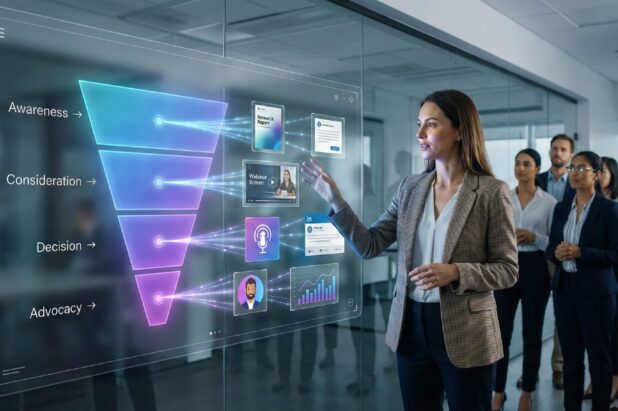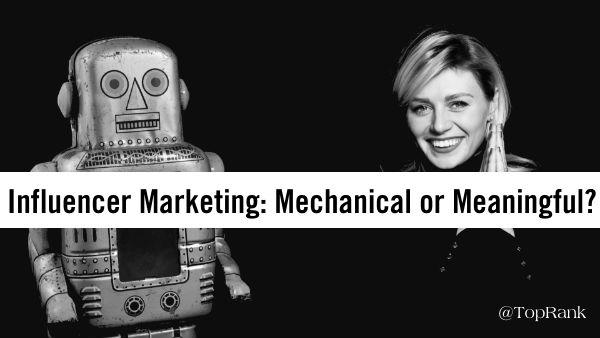
If they don’t care, they won’t share.
With the need to scale and drive efficient performance, many B2B marketers work hard to operationalize their efforts. While process brings efficiency, a transactional approach to a relationship-centric discipline can reduce effectiveness significantly.
The effect of a mechanical vs. meaningful relationship is particularly impactful when it comes to influencer marketing. This is why many in the field call it influencer relations – it’s a relationship business, not just an advertising buy.
Now that is not to say that paying B2B influencers is out of the question. In fact, it makes sense to clearly outline the situations where payment is appropriate and where it is not. For example, if you ask an influencer to attend an event and emcee a track or co-author an ebook, payment for that expertise and time is definitely appropriate. If you invite an influencer to share a quote for an article or be a guest on a podcast, then payment is less likely to be involved.
Whether payment is involved or not, what brands need to understand for effective B2B influencer marketing is the difference between mechanical and meaningful influencer engagement.
What is Mechanical Influencer Marketing?
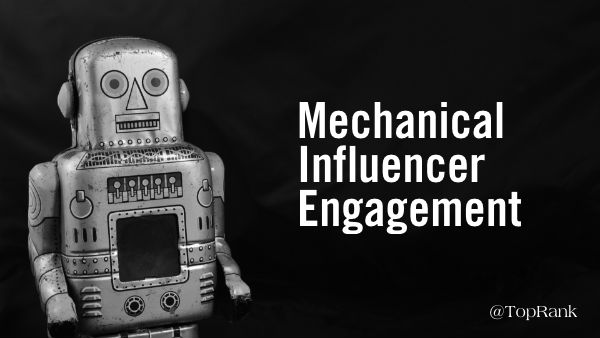
I am fortunate to have experienced both sides of the influencer marketing coin over the past 6 years. I’ve been engaged by B2B brands to do everything from share quotes (multiple times a week) to attend or speak at events to co-author significant content. At the same time, I’ve either been directly involved in architecting and managing implementation of influencer marketing programs to overseeing my team do the same for a variety of B2B brands since 2012 – even winning awards for their work.
Seeing how brands and influencers alike react to efforts towards engagement, activation and relationship building in an influencer context has been insightful. I understand why brands find themselves thinking of influencer activation as a transactional process and how being treated like a transaction can be demotivating and actually create a negative brand experience for the influencer.
In my experience, mechanical influencer engagement often starts with brands egocentrically thinking only of what they want from the influencers. “Let’s use influencers to promote our next webinar”.
Mechanical influencer identification is typically determined by the opinions of marketing staff and the perceived popularity and follower counts of the influencers.
Mechanical influencer outreach is often a template email created using a formula to superficially complement the influencer in some generic way and then ask them to share expertise. In this scenario, the act of contribution is usually done by completing a web form. Introduction, persuasion and activation are usually all handled in just one email.
Mechanical influencer co-created content can take many forms, but is most often a listicle blog post. Responses from influencers are copied and pasted into a content asset usually relying on a Twitter bio for credentials. Photos of influencers are not always used.
Mechanical influencer follow up is typically limited to a request for promoting the finished content asset. In many cases, there is no timeline provided and it could be weeks or months between the contribution and the publish date.
And that’s it. Outside of the ask to contribute and to promote, no other communication will occur until the next time someone at the brand has the idea to “use some influencers to help promote our campaign.”
Mechanical influencer engagement is short term, tactical, concerned mostly with what the brand wants and limited to a minimum viable value exchange of expertise for exposure.
Does mechanical influencer engagement work? While not ideal, it can work. Mostly with big brands people want to be associated with and with big name influencers who “play the game” on a daily basis.
But here’s the thing: In an increasingly competitive environment, the experience influencers have with brands is often what determines their willingness to participate in more tactical expertise for exposure opportunities. When that experience is mechanical and transactional, there’s not much to keep the influencer from disengaging and just deleting your next request or worse, saying yes to a more thoughtful competitor.
Long term, commoditization of influencers brings no value to influencers, the brand and certainly not brand customers.
What is Meaningful Influencer Marketing?
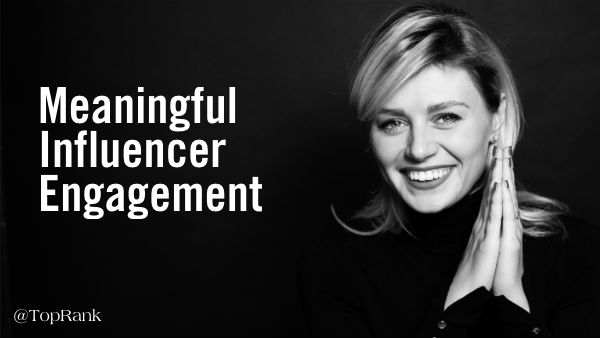
Influencer engagement that has purpose, stated objectives, clearly communicated expectations and context, empathy and relevance to what’s in it for the influencer, is meaningful.
Meaningful influencer engagement starts with an understanding of what topics will best represent the role of influence in helping the brand reach its business goals. What does the brand or solution need to be more influential about in order for customers to care?
It is with this kind of thoughtful insight that Dell Technologies is working with influencers Mark Schaefer and Douglas Karr as hosts of the Dell Luminaries podcast. Their interviews with the brightest minds in technology highlight topics of value both to the audience and the brand.
Topics drive relevant context: With those topics in mind, empathy for customers and how influencers can help ease buyer efforts to research, understand and make decisions about solutions is essential for meaningful influencer engagement.
As an example, our team led by Ashley Zeckman, researched the topics of relevance for 5 different customer segments in an influencer content program to create awareness and generate new business for Cherwell Software. Interviews and data combined to paint a picture of what topics and centers of influence mattered to the target audience through what we call a RITHM Report. Those insights informed an influencer driven content marketing campaign that led to phenomenal engagement and was ultimately attributed to 22% of all sales pipeline for the year.
Empathy drives relevant experiences: Additionally, empathy for influencers and understanding what their goals, aspirations and expectations are will help brands design influencer engagement that delivers on a great experience. In turn, influencers will be more motivated to engage, share, and advocate. Most importantly, they will be more likely to continue engaging with the brand.
“The core of social influencer marketing lies in building a solid relationship to ensure mutual value creation.” Dr. @Konstanze Alex, Director B2B Influencer Relations, Dell
Meaningful influencer identification is research based, using data about the topical relevance of the influencer and their content to the brand topic objective, data about the resonance of the influencer’s content with their network and network size. On top of the data is the human element – a review of influencer content over time to ensure shared values, consistency and quality. Working with large amounts of data and the necessary analysis is only practical with software. Platforms like Traackr, Onalytica, GroupHigh and BuzzSumo (to name a few) can be instrumental for the most effective (vs. subjective) influencer identification, engagement, measurement and program management.
Data analysis plus the qualitative review will ensure a relevant match between the influencer’s motivations and the opportunity to create value for the brand’s customers.
Meaningful influencer outreach is done according to the existing relationship (or lack thereof) with the influencer. Social romance through following, commenting and engaging will occur before easy asks that lead up to more substantial collaborations. Rather than focusing exclusively on “getting the influencer” to contribute, meaningful influencer engagement motivates the influencers to WANT to contribute.
Meaningful influencer engagement motivates the influencers to WANT to contribute.
Meaningful influencer co-created content showcases the influencers in the context of their contribution. Featuring influencers adds credibility to the brand content and it will also inspire the influencers to fully promote the content asset. Hiding the influencers behind a gated form is the ultimate buzzkill for influencer promotion.
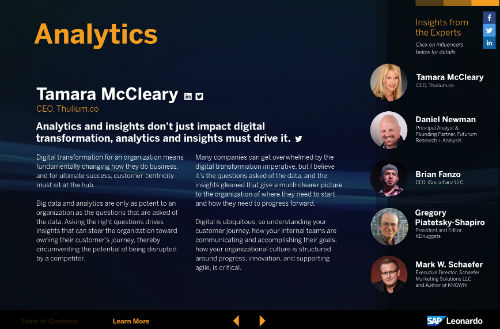
For example, when we helped SAP launch their Leonardo platform at the SAPPHIRE conference, 32 influencers were engaged to contribute their expertise to an animated/interactive microsite. The visual and content experience was so compelling, 100% of the influencers shared the microsite, many of them multiple times, resulting in over 21 million organic impressions.
As content competition increases, the bar also raises for content experiences. Including influencers in content that truly helps them stand out, such as through interactive content, will go a long ways towards building good will and inspiring robust and qualitative promotion.
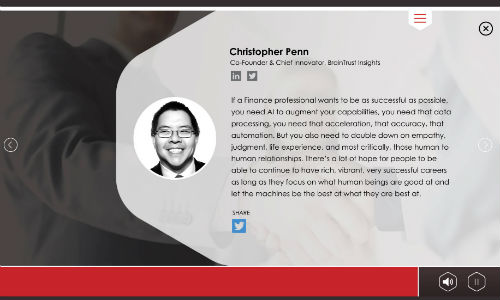
To illustrate the power of creating a great content experience, look no further than this influencer driven content program for Prophix Software. The creation of a simulated AI digital assistant named “Penny” was the foundation for an interactive experience featuring influencer voices – literally. The result of showcasing influencer expertise in such a creative way was over 600% greater engagement with the content than the benchmark. That kind of exposure is very motivating for influencers to be a part of and certainly creates an engaging experience for customers as well.
Meaningful influencer follow up starts with the very first communications and setting expectations according to the level and type of influencer. Brands can communicate on a professional level what the campaign goals are, what is expected and how the brand will support influencer promotion efforts. In fact, brands may even ask influencers for their advice on how best to promote.
Regardless of influencer sophistication level, specifications for contributions, timeline and goals should be shared. Then appropriate updates can be shared about status and what to do when. Then feedback on performance of the influencers’ contributions and sharing will help them optimize their own efforts in the future. Above all, thoughtful thank you messages should be shared, the more personalized, the better.
Always on influencer engagement: On an ongoing basis, the brands should be following the group of influencers being engaged to like, share, and interact with them on the social web. Understanding the influencers’ goals and business models can also help the brand influencer relations team to share with influencers opportunities they becomes aware of like speaking gigs and consulting opportunities.
Meaningful influencer marketing is typically long term, strategic, empathetic towards the influencer and customer experience alike. The focus is on creating a mutually valuable exchange of expertise for exposure or compensation.
Do brands always need to employ meaningful influencer engagement for their marketing?
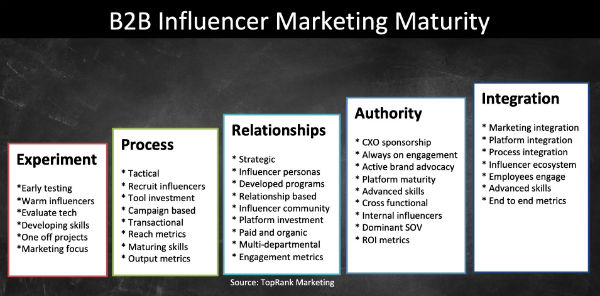
To help answer that question, I would point towards the influencer marketing maturity model I started to develop a few years ago. It shows an evolution from Experimentation, to Process, to Relationships to Authority to Integration.
That is to say, it’s fine to test the influencer marketing waters tactically or even mechanically, but brands that want to fully realize the value of working with influencers to increase content quality, engage with new and hard to reach audiences in a credible way and that want to inspire advocacy amongst those who are most trusted by customers, then meaningful, relationship-driven influencer relations is a must.

